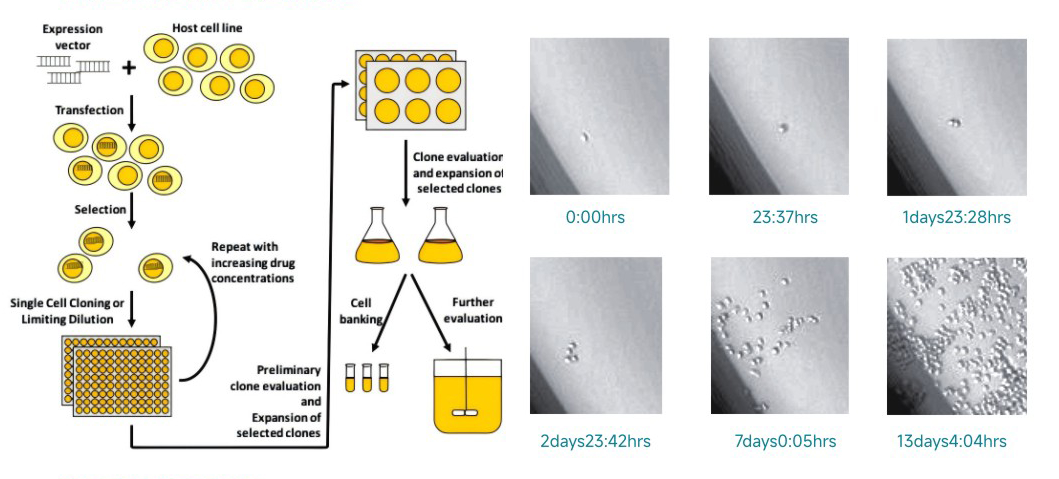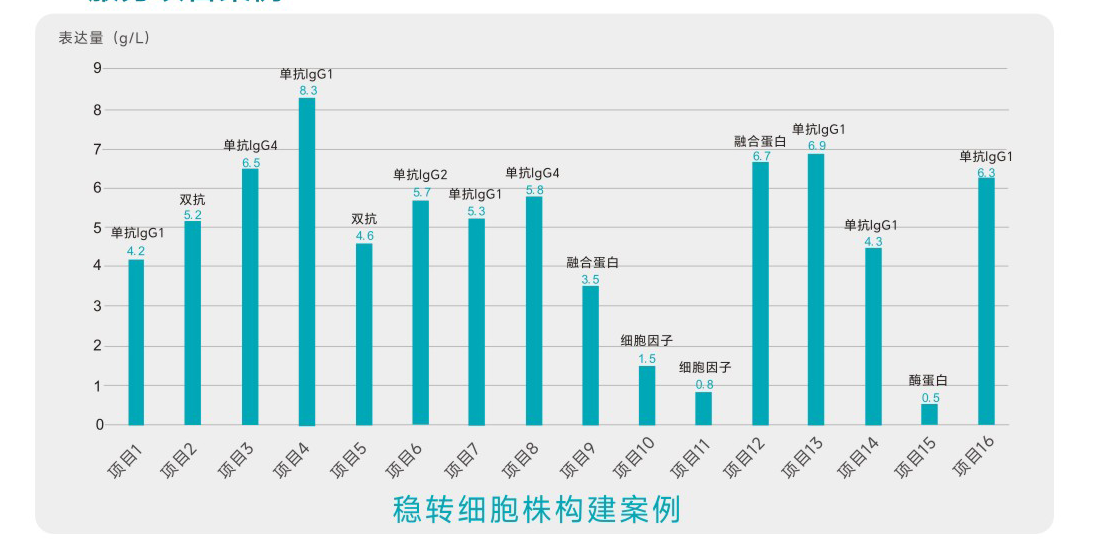
Stable cell line construction
The CHO-K1 host and its accompanying vector are clearly sourced and authorized, originating from the wild-type CHO-K1 cells of the European Collection of Authenticated Cell Cultures (ECACC). The expression vector is pKS001, using glutamine synthetase (GS) as a selection marker, with methionine sulfoximine (MSX) as the selection pressure; electrotransfection is used, with an efficiency of 90% or higher; rich experience in signal peptide optimization, selection marker setting, and codon optimization.
The CHO-K1 Q host and its accompanying vector are clearly sourced and authorized, originating from the European Collection of Authenticated Cell Cultures (ECACC) wild-type CHO-K1 cells. The expression vector is pKS001, using glutamine synthetase (GS) as a selection marker, with methionine sulfoximine (MSX) as the selection pressure; electrotransfection is used, with an electrotransfection efficiency of 90% or higher; rich experience in signal peptide optimization, selection marker setting, and codon optimization.
A minipool screening method, combined with limiting dilution, is used with 0.4 cells per well, and a monoclonal imaging instrument (such as CSI, Cell Metric CLD, Nyone, etc.) is used for imaging and tracking monoclonal growth images, fully meeting the requirements for both China and US submissions.
The cycle from constructing the DNA plasmid to obtaining a high-expression stable cell line is 4-6 months, and it can meet the requirements of PDL60 cell line growth, expression stability, and genetic stability.
The expression levels of antibodies, bispecific antibodies, and fusion protein monoclonal cell lines are generally 3.0-8.0 g/L, and the expression levels in shake flasks, 3L, and 200L reactors are relatively consistent.
Stable Cell Line Construction Process

Service Cases

Service Content
Stage | Project | Content |
1 | 4 Molecule Constructions* | Sequence analysis, signal peptide design, gene synthesis and expression vector construction, plasmid preparation for transfection |
2 Molecule Transient Transfection Assessment and HTRF Standard Preparation | Transient expression using the constructed plasmid, expression level assessment, purification and detection of SEC and CE, used as protein detection standards | |
Establishment and Screening of 2 Minipools* | Two rounds of a total of 2-4 transfections, each transfection plating 10 96-well plates, performing cell population pressure screening, cell population expression level assessment, and protein quality assessment | |
| Top Minipool Material Production (Optional) | 3L or 50L reactors are used to culture the minipool with the highest expression level. The harvested samples are purified and the protein quality is tested: SEC-HPLC, nrCE-SDS, rCE-SDS, etc. (Acceptable standards: SEC-HPLC > 95%, Endotoxin < 0.5EU/mg) |
| Monoclonal Screening | Based on titer testing and photographic data, approximately 40 monoclonal cell lines are screened for Fed-batch culture. The best 3 clones are selected to confirm that the product sequence is correct, and a preliminary shake flask batch fed-batch culture process is established. |
2 | Establishment of the Master Cell Bank | 25 vials of the master cell bank are established for each of the top 3 clones, and 4-6 vials of all other cell lines are cryopreserved. The consistency of the revived master cell bank is tested, and sterility and mycoplasma testing are performed. |
| Cell Line Stability Testing | Cell line stability testing that meets the requirements for IND submission in China and the US: Cell line stability studies of no less than 60 PDL are conducted (including pressure passage and post-PDL30 pressure release passage groups), PCB, PDL15 (MCB/mMCB), PDL30 (WCB/mWCB), PDL45, PDL60 fed-batch experiments are performed, including cell growth stability and product expression stability (acceptable standard: expression level decrease not exceeding 30%, no significant change in quality) |
3 | English Report (Optional) | English versions of the cell line construction report, master cell bank establishment report, and stability report |
4 | Reactor Evaluation of Top 3 Clones (Optional) | Evaluate the performance of different clones in 3-15L bioreactors using existing platform processes. |
5 | Submission Material Preparation (Optional) | Preparation of submission materials in CTD format for the above content |
Service Description
Remarks: For diagnostic reagent customers who need stable cell line construction services, the cost of constructing a bulk pool from the amino acid sequence provided by the customer is 200,000-250,000 RMB. The delivery needs to be confirmed based on the customer's required expression level. Generally, Xi Chang Biology can guarantee the selection of monoclonal cell lines with an expression level of 4g/L.
Delivery Materials
Host Cell Certificate
Host Cell Traceability Documents (purchase contract, invoice, host cell origin report, etc.)
Cell Line Construction Report
Includes a description of the process and experimental results of vector construction, transfection, cell population screening, monoclonal cell line screening, and Top 3 clone reactor evaluation (if any).
Master Cell Bank Establishment and Stability Report
Includes a description of the process and experimental results of master cell bank establishment and cell line stability testing.
Product Delivery
All minipools, monoclonal cell lines, and master cell banks cryopreserved during the cell line construction process. If protein expression production is involved, the protein samples required will also be included.
Documents


